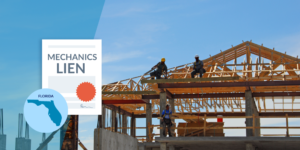
Mechanics liens are a powerful remedy to recover payment on construction projects: True. Mechanics liens guarantee that you’ll be paid: False.
Even if you go through the entire lien process and have a valid claim, it doesn’t necessarily mean that you’ll get paid. One of the most overlooked aspects of mechanics lien rights is the issue of lien priority.
Lien priority determines who gets paid first if the property is eventually foreclosed. The further back you are in line, the less likely there’ll be enough funds leftover, if any.
Let’s take a look at when and how priority is determined for Florida construction liens.
When do Florida construction liens attach?
The thing that you’ll need to consider is when the lien “attaches” to the property: The general rule in Florida is first in time, first in right. Meaning whichever claims are filed first, will typically be paid first in a foreclosure proceeding.
But rarely are things this simple. A construction lien’s priority can be affected by a number of different factors. Before we dive into the specifics, let’s break up construction liens into two main categories.
1. Liens that always attach at time of filing
The first category, covers “design professional liens” under §713.03, and “subdivision improvement liens” under §713.04.
- Design professional liens include claims by architects, landscape architects, interior designers, engineers, surveyors, and mappers.
- Site improvement liens include claims by anyone who performed work to make the land suitable preparation for the construction or improvement. Think grading, leveling, excavating, utility work, sidewalk/curb paving, etc.
Construction liens for this type of work “attach” at the time of filing/recording. Period. Any liens or claims filed after the filing date will have inferior priority.
2. Liens that attach at the time of filing, OR relate back to the Notice of Commencement
This second category covers construction liens filed by contractors, subcontractors, material suppliers, equipment lessors, and laborers. Like the previous category, these liens will attach at the time they are filed or recorded in the county recorder’s office — but there’s a twist.
If a Notice of Commencement (NOC) is filed on the project, then these types of construction liens will “relate back” to the time the Notice of Commencement was recorded. In other words. If a NOC was filed, then all mechanics liens filed on the project will attach at the same time — when the NOC was filed.
Read More: Florida Subcontractor Lien Has Priority Despite Notice of Commencement Error
What takes priority in a foreclosure action
Now that we’ve established when a lien attaches, the next issue to tackle is how they are ranked for priority purposes.
Priority against mortgages and loans
As stated above, the rule is “first in time, first in right.” This means that any construction lien will have priority over any conveyance, encumbrance, or demand that was recorded after the lien attached. However, any loan, mortgage, or other encumbrance recorded prior to the lien’s attachment will be paid out prior to the debts secured by a construction lien.
Practically speaking, construction loans and mortgages will rarely be ranked lower than a construction lien. Few lenders will be willing to loan funds if a Notice of Commencement has yet to be filed.
Priority against other liens
As far as priority is concerned among various lienors, the Florida Statutes provide a list of classes of construction lienholders ranked in order of priority under §713.06(4)(a):
“In determining the amounts for which liens between lienors claiming nuder a direct contract shall be paid by the owner or allowed by the court within the total amount fixed by the direct contract and under the provisions of this section, the owner or court shall pay or allow such liens in the following order:
- Liens of all laborers
- Liens of all persons other than the contractor
- Lien of the contractor
Each class will be paid in full before the next class can collect. And, if there is not enough money to pay one class of lienors in full, then they will share the proceeds pro rata.”
As you can see, direct contractors are at the bottom of the totem pole.
Why? Because if they go unpaid, they still have contractual privity with the owner. This means lawsuits for breach of contract and other such claims can be made directly against the owner/customer.
What happens if construction ceases or the direct contract is terminated?
This is where things get a little tricky. When a construction project ceases, or the direct contract is terminated before completion, the owner has two options if they wish to recommence work:
1. Pay off liens and refile the NOC
The owner can opt to pay all lienholders in full or pro rata in the order listed above (i.e. laborers, then subs and suppliers, then direct contractors). After which, the owner may file a Notice of Recommencement to restart work on the project. If this is the case, then any lien filed on the recommenced work will take priority from the date the recommencement notice was filed.
2. File an affidavit allowing lienors to preserve their priority
Under this second option, an owner can file an affidavit with the clerk’s office stating that they plan to recommence construction. The affidavit should include a list of lienors that have been paid in full, and those that haven’t. A notice of the filed affidavit must be sent to each lienor listed who provided a Notice to Owner.
In this scenario, lienors have 30 days from receipt of the notice to file their claim to retain their priority ranking. If not, any lien filed on the recommenced construction will have priority against any previous liens. This includes both those who already have a filed claim and those “prospective lienors” who have lien rights on the project, but yet to file their claim.
One incredibly important thing to keep in mind: Although amended lien claims in Florida will reset the deadline clock, that’s not the case under this §713.07(4) procedure. The Florida courts have explicitly held that refiling claims on recommenced projects will not extend your 1-year foreclosure deadline. The clock still runs from when the initial claim was filed, so be sure to track your deadlines accordingly.
Familiarize yourself with lien priority rules
All of these factors should be taken into consideration when deciding whether or not to enforce your construction lien claim. After all, there’s only so much equity in a single piece of real property. If you find yourself at the back of the line, there may be little, if any left to go around.
Dive deeper: Mechanics Lien Foreclosures: Is It Worth It?
Mechanics liens are a great way to increase the pressure on property owners to pay. And typically, foreclosures aren’t necessary. But if it reaches that point, and your claim is at the bottom end of the totem pole, you may want to consider alternative means of recovery; such as claims for breach of contract, unjust enrichment, quantum meruit, or claims under Florida’s prompt payment laws against your hiring party.
If the deadline to enforce your claim is steadily approaching, you should consult with a Florida-based construction attorney to discuss these factors and what your best options are moving forward.

Discover how a Florida contractor’s average DSO went from 60 days to 14 days after sending notices on every job.
